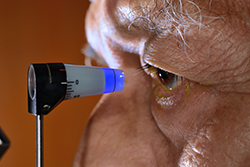 Glaucoma is a condition that results in damage to the optic nerve. The optic nerve carries visual information from the eye to the brain, and as it is damaged, vision is lost. Glaucoma usually develops gradually, often without any other symptoms, and because of this, vision loss can be significant before glaucoma is detected. In the US alone, more than two million people have glaucoma.
Glaucoma is a condition that results in damage to the optic nerve. The optic nerve carries visual information from the eye to the brain, and as it is damaged, vision is lost. Glaucoma usually develops gradually, often without any other symptoms, and because of this, vision loss can be significant before glaucoma is detected. In the US alone, more than two million people have glaucoma.
The main risk factor is elevated eye pressure. While glaucoma is typically a condition that affects people over age 50, it can sometimes affect younger adults and even children. People with a family history of glaucoma and/or African or Hispanic descent are at a higher risk of developing this condition.
Routine eye exams are the best way to identify glaucoma in its early stages, and before significant vision loss has occurred. Glaucoma results in optic nerve damage and subsequent vision loss is not reversible. However, glaucoma can be controlled with treatment and blindness can be prevented.

Excellent treatments are available for glaucoma. Treatment is aimed at lowering the pressure in the eye. Pressure control is usually achieved with medications or laser therapy. When these are not enough, surgery is performed. A variety of glaucoma procedures are performed by our glaucoma specialists, tailored to the individual’s needs.
SLT, or selective laser trabeculoplasty, is an in-office procedure that aims light energy at the natural drain of the eye. This can allow for the improved outflow of fluid through the eye’s natural drain, known as the trabecular meshwork. This repeatable procedure is intended to lower the eye pressure and can be used along with or in place of eye drops to control your glaucoma.
Laser iridotomy is a treatment for closed-angle glaucoma. It creates a tiny opening in the colored part of the eye, or iris, to prevent backup of fluid behind the iris and allow it to flow into the natural drainage system.
Trabeculectomy surgery creates a new drain using the natural tissue of the eye. An anti-scarring medication called mitomycin is used at the time of the surgery to help keep the drain open. This procedure is very effective at lowering eye pressure and stopping the progression of glaucoma.
Tube-shunt surgery also creates a new drain, using a soft plastic implant to maintain flow. Most people cannot feel the implant once it has healed. Tube shunts have a proven track record of controlling eye pressure, even for people who have had other glaucoma procedures in the past.
The iStent is a tiny device that is placed into the natural drain of the eye, to allow for better outflow of fluid and lower eye pressure. It is currently approved for use at the time of cataract surgery and offers a minimally invasive option for people with mild or moderate glaucoma to help lower eye pressure and possibly reduce the need for glaucoma drops.
The CyPass is a microscopic surgical device that is implanted during cataract surgery to enhance the outflow of fluid through one of the eye’s natural drainage channels, the supraciliary space. This is a minimally invasive procedure that can help to lower the eye pressure and reduce the need for glaucoma drops.
The micropulse P3 laser is used to treat the fluid-producing structure inside the eye called the ciliary body. The treatment causes a reduction in the production of fluid inside the eye, which can help to lower the eye pressure. No incision is needed. This procedure offers a quick recovery time and can be repeated if necessary.
499 Farmington Avenue, Suite 100
Farmington, CT 06032
Office Telephone: 860-678-0202
295 Western Boulevard
Glastonbury, CT 06033
Office Telephone: 860-678-0202